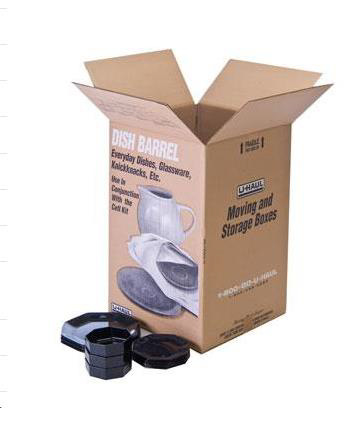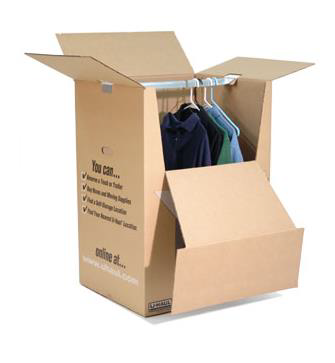Overview of Moving Boxes
Before we can start in on your household inventory estimate, you first need a basic understanding of the various types of moving boxes, including their sizes, shapes, and their purposes. These standard-size boxes are sold at all U-Haul Centers. Using them properly is a key factor in having a successful move. Let’s start with a quick overview of the eight main types of boxes that I recommend using on your household move:
- Extra Large Box 6.0 cubic feet
- Large Box 4.5 cubic feet
- Medium Box 3.0 cubic feet
- Small Box 1.5 cubic feet
- Dish Barrel Box 5.2 cubic feet
- Shorty Wardrobe 9.4 cubic feet
- Grand Wardrobe 14.0 cubic feet
- Mirror Box 4.0 cubic feet
You will end up estimating how many of each type of box you need as part of a Furniture Inventory template that I will introduce shortly. First, let’s understand how to use these boxes.
When working with boxes -- in general -- the heavier the item, the smaller the box. Books and tools go into the 1.5 cubic foot Small Box (Figure 2.2), which can be quite heavy but can be lifted and carried because of its small size.

Figure 2.2: Small Box

Figure 2.3: Medium Box
Source: www.uhaul.com
The next size box, the Medium, is 3.0 cubic feet (Figure 2.3). It has twice the capacity of the Small Box, and is used in just about every room. The Medium Box, even though it is bigger, will generally weigh less than the Small Box because the Small is meant for heavy items like books.
The Large Box is 4.5 cubic feet (Figure 2.4), and the Extra Large Box (Figure 2.5) is 6.0 cubic feet. These boxes are used for bulky items that are relatively light, like large toys, linen closet items, etc. Avoid placing heavy items such as books or tools in large/extra-large boxes, they will be so heavy you will not be able to move them! As you load items into boxes, you will get the hang of it – small heavy objects go into the Small box, and lighter bulkier items work their way up through the Medium, Large and Extra Large box sizes.

Figure 2.4: Large Box

Figure 2.5: Extra Large Box
In addition to the “standard” shape boxes, Small through Extra-Large, I want to review four very key specialty size boxes: the “Dish Barrel”, the “Shorty Wardrobe Box”, the “Grand Wardrobe Box”, and the “Mirror Pack.”
The Dish Barrel® box, Figure 2.6, is a large, deep box (28 inches high) designed to hold dishes and glassware from the kitchen and from dining room hutches. The Dish Barrel is ‘thicker’ than the other boxes, and is reinforced to both protect and hold the weight of dishes and glassware. The Dish Barrel is the exception to the rule about not putting heavy items into a large box. In fact, the whole purpose of the Dish Barrel is to load it up so that it ends up being very, very heavy. This box is rated for up to 120 pounds. Why the heavy box? By wrapping dishes and glassware in wrapping paper, and loading the

Figure 2.6: The “Dish Barrel” specialty box
Source: www.uhaul.com
items into the Dish Barrel, the items will not move during transport and will stay protected from breakage. Also, the Dish Barrel ends up being so heavy, that it is loaded on the floor of the truck, and other items are stacked on top (but more about that when we read about loading the truck in Chapter 10).
Why is it called a Dish Barrel? Back in the old days, before cardboard boxes were invented, movers used wooden barrels to load dishes, hence – the Dish Barrel. (And no, the author is not old enough to have actually used the wooden barrels). The Dish Barrel is more expensive than a regular size box, but it is worth the investment. In thirty years of both professional and U-Haul moving, I never once experienced a broken dish or glass when unpacking a Dish Barrel! And that includes the finest stemware.
The next two specialty boxes are wardrobe boxes. As the name implies, you use a wardrobe box for items that hang in closets such as winter coats, dresses and suits. These clothing items do not lend themselves to being folded and placed into standard size boxes.
As you can see, the wardrobe boxes are large and are designed to allow clothing to hang from a metal hanging bar. The bar attaches to the top of the box, and clothing is loaded into the boxes on hangars, just like having a mobile closet. The Shorty Wardrobe box, (Figure 2.7), will handle everything except long dresses and coats, which go into the Grand box. The Shorty box is 9.4 cubic feet, while the Grand Wardrobe box (Figure 2.8) is 14 cubic feet. The wardrobe boxes will generally be loaded on the floor of the truck, and items will be stacked on top.
The final specialty box is the very flexible 4-panel Mirror Box, or Mirror Pack. The Mirror Box is shown below in Figure 2.9 This is the ideal box for protecting large pictures and mirrors. This box comes in 4 pieces, each covering a quarter of the item being shipped. You assemble this box by fitting together the 4 quarters. Because the 4 pieces overlap, the box can expand or contract to fit a variety of mirror or picture sizes.

Figure 2.9 The 4-Panel Mirror Box
Source: www.uhaul.com
This is the box that will be used to protect dresser mirrors. It can also be used for flat panel TV’s, and for paintings/pictures/posters. I have also used it to protect removable glass tops to coffee tables. If you prefer, there are specialty boxes made specifically for flat screen TV’s.


